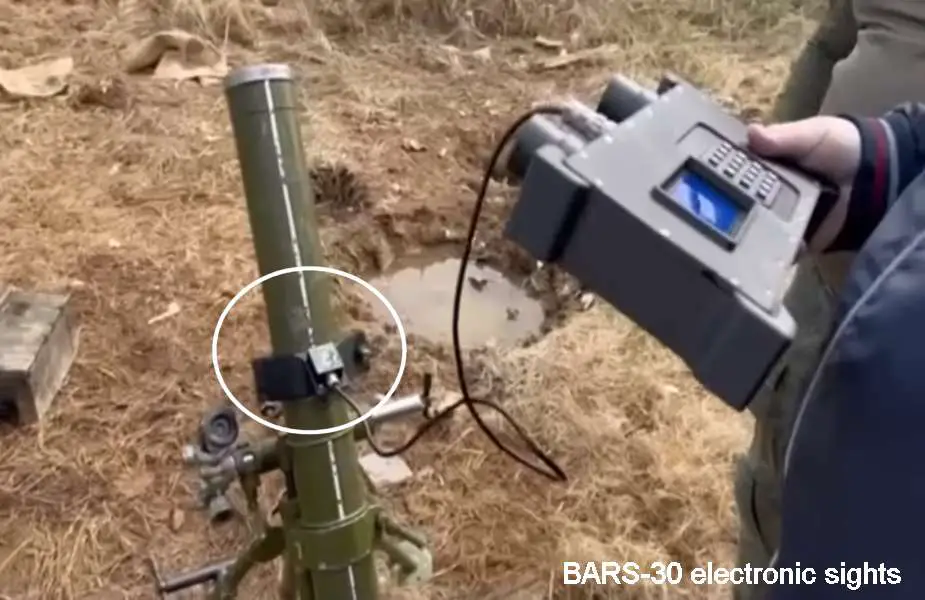Breaking news
Russia enhances light artillery precision in Ukraine with new BARS-30 electronic sights.
According to the Russian social network Telegram, the Russian military is using BARS electronic sights for grenade launchers and mortars in Ukraine. Developed by DB Bars, these sighting systems provide new advanced capabilities for artillery operations.
Follow Army Recognition on Google News at this link

BARS-30 electronic sighting system is specifically designed for mortars and automatic grenade launchers (Picture source: Russian social media)
The BARS-30 electronic sighting system is specifically designed for the AGS-17/30 automatic grenade launchers. It boasts a high level of precision, attributed to its use of a mathematical model for projectile flight, which takes into account various environmental factors affecting ballistics. This approach differs from traditional systems that rely on empirical artillery range tables.
A notable feature of the BARS-30 system is its compatibility with standard optical sights, such as the PAG-17, allowing for flexible integration into existing artillery configurations without interference.
Recent images have surfaced showing Russian troops using these electronic sights in Ukraine, equipped with grenade launchers or mortars. However, it is not possible to determine whether this was part of a testing phase conducted at the end of 2023 in anticipation of later deployment in Ukraine, or a direct deployment in the field.
The developers from DB Bars (a factory developing various electronic sighting systems) have reportedly confirmed the use of their products by the Russian forces in Ukraine. The BARS-30 system has undergone successful testing operations and has been recommended for active deployment.
DB Bars is also working on the development of the unified BARS-82-120 system for 82 mm (2B14 Podnos) and 120 mm (2S12 Sani) mortars, indicating ongoing efforts to expand the range of electronic sighting solutions available to the Russian military.
Plans seem to include the development of more complex sights for towed and self-propelled howitzers, as well as for the 100 mm cannons of BMP-3 and BMD-4 vehicles, demonstrating Russia's commitment to modernizing its military capabilities in the field of artillery warfare.
The implementation of advanced electronic sighting systems such as the BARS-30 could enable Russian artillery units to increase their accuracy on the battlefield while retaining a weapon system that has long been present in various units, potentially influencing the dynamics of the conflict in Ukraine and shaping future combat strategies.
Indeed, it is important to note that in response to the needs of the war, many Russian factories are now operating in three shifts, six days a week. This ramp-up in production has resulted in a sustained output, with more than 500 missiles and drones launched at Ukraine in five days at the end of 2023, according to President Zelensky. On the front, Russia has increased its artillery munition expenditure to about 10,000 shells per day, and more than 3,700 armored vehicles were delivered in 2023. In addition to conventional weapons, the Russian defense industry delivered 22,000 drones, and hundreds of Lancet munitions, and started production of the Geran-2, an improved version of the Iranian Shahed attack drone.
The priorities of the Russian defense industry for a prolonged war are clear: to equip and supply the Russian forces fighting in Ukraine, and to equip new units as they are formed. To achieve this, the Russian defense industry has increased the production of artillery munitions, armored vehicles, drones, and missiles. This is accompanied by significant structural reforms within the defense industry, with mergers of companies for more efficient production management.
Although Russia appears to be making progress in adapting and producing weapons and munitions, challenges remain particularly the need to meet production targets without compromising quality. The situation raises questions about the long-term effectiveness of this ramp-up in production and how it might influence the outcome of the conflict in Ukraine.























